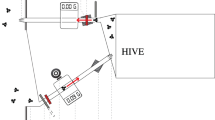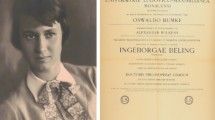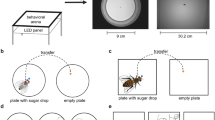Abstract
The honey bee time memory enables foragers to return to a profitable food source in anticipation of the time of day at which they previously collected food from that source. The time memory thus allows foragers to quickly resume exploiting a source after interruption, at the appropriate time of day, without the costs associated with having to rediscover it. A portion of a foraging group (the persistent foragers) will reconnoiter a previously profitable source and may do so for several days. The remaining bees (the reticent foragers) await confirmation of availability before revisiting the source. Recent work has shown that both persistent and reticent bees make extracurricular flights to alternative sources when one food source ceases being productive. Little else, however, is known about reticent foragers. In the present study, we determined that reticent bees congregate near the hive entrance in anticipation of the learned foraging time as do persistent foragers. We then confirmed that the food-anticipatory clustering takes place on the waggle dance floor, as suspected, but also found differences in the number of days that persistent and reticent foragers continue clustering. Finally, we found that persistent foragers had significantly more rewards per day at the source than did reticent foragers, supporting the hypothesis that experience at a food source influences a forager’s decision to become either persistent or reticent. Our findings demonstrate that persistence and reticence are not immutable characteristics of foragers themselves but rather strategies they employ toward different food sources.
Significance statement
Much has been learned in recent years about the honey bee time memory and foraging behavior. Receiving scant attention, however, is the phenomenon of forager bees gathering near the hive entrance, anticipating the time of day when previously productive food sources become available. We show that both persistent and reticent bees (foragers that do and do not investigate the source, respectively) congregate on the waggle dance floor at the appropriate time of day, but, in the absence of food at the source, persistent bees continue to show this behavior a day or two longer than reticent bees do. We also show that experience with the source influences the decision to become persistent or reticent. Our results reveal how foraging experience influences the individual bee’s decision making, thereby providing insights into how foragers are reallocated efficiently among different resources in the environment.




Similar content being viewed by others
References
Bateson M, Desire S, Gertside SE, Wright GA (2011) Agitated honeybees exhibit pessimistic biases. Curr Biol 21:1070–1073
Beekman M (2005) How long will honey bees (Apis mellifera L.) be stimulated by scent to revisit past-profitable forage sites? J Comp Physiol A 191:1115–1120
Beekman M, Oldroyd BP, Myerscough MR (2003) Sticking to their choice—honey bee subfamilies abandon declining food sources at a slow but uniform rate. Ecol Entomol 28:233–236
Beier W (1968) Beeinflussung der inneren Uhr der Bienen durch Phasenverschiebung des Licht-Dunkel-Zeitgebers. Z Bienenforsch 9:356–378
Beier W, Lindauer M (1970) Der Sonnenstand als Zeitgeber für die Biene. Apidologie 1:5–28
Beling I (1929) Über das Zeitgedächtnis der Bienen. Z Vgl Physiol 9:259–388
Biesmeijer JC, Seeley T (2005) The use of waggle dance information by honey bees throughout their foraging careers. Behav Ecol Sociobiol 59:133–142
Bitterman ME, Menzel R, Fietz A, Schäfer S (1983) Classical conditioning of proboscis extension in honeybees (Apis mellifera). J Comp Psychol 97:107–119
Butler CG (1945) The influence of various physical and biological factors of the environment on honeybee activity. An examination of the relationship between activity and nectar concentration and abundance. J Exp Biol 21:5–12
Cao TT, Hyland KM, Malechuk A, Lewis LA, Schneider SS (2007) The influence of the vibration signal on worker interactions with the nest and nest mates in established and newly founded colonies of the honey bee, Apis mellifera. Insect Soc 54:144–149
Clark PJ, Evans FC (1954) Distance to nearest neighbor as a measure of spatial relationships in populations. Ecology 35:445–453
Corbet SA, Delfosse ES (1984) Honeybees and the nectar of Echium plantagineum L. in southeastern Australia. Aust J Ecol 9:125–139
Dukas R (2001) Effects of perceived danger on flower choice by bees. Ecol Letters 4:327–333
Edge AA, Van Nest BN, Johnson JN, Miller SN, Naeger NL, Boyd SD, Moore D (2012) Diel nectar secretion rhythm in squash (Cucurbita pepo) and its relation with pollinator activity. Apidologie 43:1–16
Eisenhardt D (2012) Extinction learning in honey bees. In: Galizia CG, Eisenhardt D, Giurfa M (eds) Honeybee neurobiology and behavior: a tribute to Randolf Menzel. Springer, Berlin, pp. 423–438
Frisch B, Aschoff J (1987) Circadian rhythms in honeybees: entrainment by feeding cycles. Physiol Entomol 12:41–49
Gil M, De Marco RJ (2009) Honeybees learn the sign and magnitude of reward variations. J Exp Biol 212:2830–2834
Gil M, De Marco RJ, Menzel R (2007) Learning reward expectations in honeybees. Learn Mem 14:491–496
Giurfa M, Núñez JA (1992) Foraging by honeybees on Carduus acanthoides: pattern and efficiency. Ecol Entomol 17:326–330
Granovskiy B, Latty T, Duncan M, Sumpter DJT, Beekman M (2012) How dancing bees keep track of changes: the role of inspector bees. Behav Ecol 23:588–596. doi:10.1093/beheco/ars002
Kleber E (1935) Hat das Zeitgedächtnis der Bienen biologische Bedeutung? Z Vgl Physiol 22:221–262
Körner I (1939) Zeitgedächtnis und Alarmierung bei den Bienen. Z Vgl Physiol 27:445–459
Mattila HR, Seeley TD (2014) Extreme polyandry improves a honey bee colony’s ability to track dynamic foraging opportunities via greater activity of inspecting bees. Apidologie 45:347–363. doi:10.1007/s13592-013-0252-30
Menzel R (1968) Das Gedächtnis der Honigbiene für Spektralfarben I. Kurzzeitiges und lanzeitiges Behalten. Z Vgl Physiol 60:82–102
Menzel R, Erber J (1978) Learning and memory in bees. Sci Am 239:80–87
Mistlberger R (1994) Circadian food-anticipatory activity: formal models and physiological mechanisms. Neurosci Biobehav Rev 18:171–195
Moore D, Doherty P (2009) Acquisition of a time-memory in forager honey bees. J Comp Physiol A 195:741–751
Moore D, Rankin MA (1983) Diurnal changes in the accuracy of the honeybee foraging rhythm. Biol Bull 164:471–482
Moore D, Siegfried D, Wilson R, Rankin MA (1989) The influence of time of day on the foraging behavior of the honeybee, Apis mellifera. J Biol Rhythms 4:305–325
Moore D, Van Nest BN, Seier E (2011) Diminishing returns: the influence of experience and environment on time-memory extinction in honey bee foragers. J Comp Physiol A 197:641–651
Naeger NL, Van Nest BN, Johnson JN, Boyd SD, Southey BR, Rodriguez-Zas SL, Moore D, Robinson GE (2011) Neurogenomic signatures of spatiotemporal memories in time-trained forager honey bees. J Exp Biol 214:979–987
Neih JC (1998) The honey bee shaking signal: function and design of a modulatory communication signal. Behav Ecol Sociobiol 42:23–36
Pittendrigh CS (1958) Perspectives in the study of biological clocks. In: Buzzati-Traverso AA (ed) Perspectives in marine biology. University of California Press, Berkeley, pp. 239–268
Rabinowitch HD, Fahn A, Meir T, Lensky Y (1993) Flower and nectar attributes of pepper (Capsicum annuum L.) plants in relation to their attractiveness to honeybees (Apis mellifera L.). Ann Appl Biol 123:221–232
Reinhardt J, Srinivasan MV, Zhang S (2004) Scent-triggered navigation in honeybees. Nature 427:411
Renner M (1955) Über die Haltung von Bienen in geschlossenen, künstlich beleuchteten Räumen. Naturwissenschaften 42:539–540
Renner M (1957) Neue Versuche über den Zietsinn der Honigbiene. Z Vgl Physiol 40:85–118
Saunders DS (2002) Insect clocks. Elsevier Press, Boston
Schneider SS, Stamps JA, Gary NE (1986) The vibration dance of the honey bee I. Communication regulating foraging on two time scales. Anim Behav 34:377–385
Seeley TD (1995) The wisdom of the hive. Harvard University Press, Cambridge, MA
Seeley TD, Towne WF (1992) Tactics of dance choice in honey bees: do foragers compare dances? Behav Ecol Sociobiol 30:59–69
Seeley TD, Camazine S, Sneyd J (1991) Collective decision-making in honey bees: how colonies choose among nectar sources. Behav Ecol Sociobiol 28:277–290
Seeley TD, Wiedenmüller A, Kühnholz S (1998) The shaking signal of the honey bee informs workers to prepare for greater activity. Ethology 104:10–26
Tautz J (2008) The buzz about bees: biology of a superorganism. Springer-Verlag, Berlin
Van Nest BN, Moore D (2012) Energetically optimal foraging strategy is emergent property of time-keeping behavior in honey bees. Behav Ecol 23:649–658
Visscher PK, Seeley TD (1982) Foraging strategy of honeybee colonies in a temperate deciduous forest. Ecology 63:1790–1801
von Buttel-Reepen HB (1900) Sind die Bienen Reflexmaschinen? Biol Zbl 20:1–82
von Frisch K (1967) The dance language and orientation of bees. Harvard University Press, Cambridge (MA)
Wagner AE, Van Nest BN, Hobbs C, Moore D (2013) Persistence, reticence, and the management of multiple time memories by forager honey bees. J Exp Biol 216:1131–1141
Wahl O (1932) Neue Untersuchungen über das Zeitgedächtnis der Bienen. Z Vgl Physiol 16:529–589
Wahl O (1933) Beitrag zur Frage der biologischen Bedeutung des Zeitgedächtnisses der Bienen. Z Vgl Physiol 18:709–717
Zar JH (1996) Biostatistical analysis, 3rd edn. Prentice Hall, Upper Saddle River, NJ
Acknowledgments
The authors thank Jennifer N. Johnson, Andrea A. Edge, Sam D. Boyd, Curtis Gill, Joanna Magner, Michael Feathers, and Emily Hardgrave for the invaluable help in the field and two anonymous reviewers for many constructive suggestions on the manuscript. Funding was provided by the Denise I. Pav Research Grant, Department of Biological Sciences, East Tennessee State University (B.V.N.) and the US Department of Agriculture grant no. 2006-35302-17278 (D.M.).
Author information
Authors and Affiliations
Corresponding author
Ethics declarations
All applicable institutional and national guidelines for the care and use of animals were followed.
Conflict of interest
The authors declare that they have no competing interests.
Additional information
Communicated by D. Naug
Electronic supplementary material
ESM 1
(PDF 240 kb)
Rights and permissions
About this article
Cite this article
Van Nest, B.N., Wagner, A.E., Hobbs, C.N. et al. Dance floor clustering: food-anticipatory behavior in persistent and reticent honey bee foragers. Behav Ecol Sociobiol 70, 1961–1973 (2016). https://doi.org/10.1007/s00265-016-2202-3
Received:
Revised:
Accepted:
Published:
Issue Date:
DOI: https://doi.org/10.1007/s00265-016-2202-3




